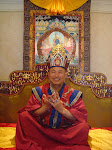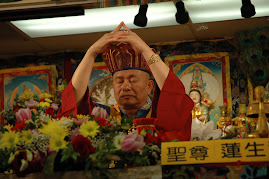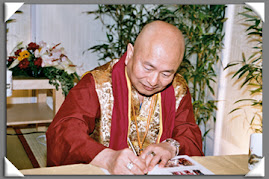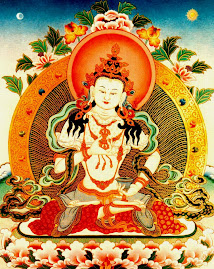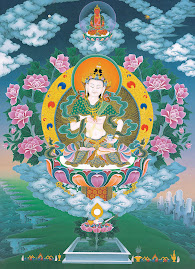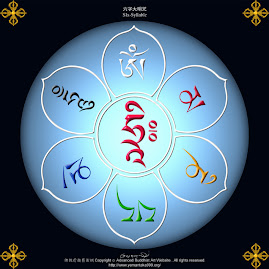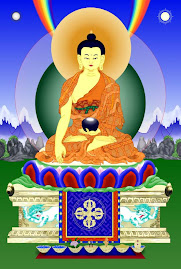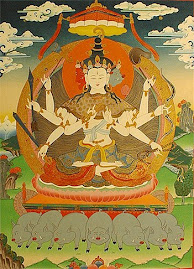
| HOW TO SET UP A TANTRIC SHRINE |
Far too many disciples remain uncertain as to the layout of a tantric shrine. It is in response to frequent requests for such information that this article is written.
The most important reason for setting up a tantric shrine is to dedicate an area for peaceful and uninterrupted daily cultivation.
One should practice before the tantric shrine at least once, and ideally twice, each day. The tantric shrine is both for personal cultivation and for making offerings to the Buddhas and Bodhisattvas.
An elaborate and solemnly adorned tantric shrine can induce joy and reverence in the practitioner, and inspire cultivation. Making offerings inside a tantric shrine is equivalent to "offering to the Triple Jewels above, and aiding the Four forms of birth below," and magnifies in subtle ways one’s fortune and wisdom.
Master Lu knows the great importance of locating the shrine in a room capable of "storing spirit and concentrated energy"; therefore, the statues of the Buddhas and Bodhisattvas should be installed against a sturdy wall which has neither windows nor openings. Moderate lighting should be used.
To begin with, the main deity at the center should be one’s own personal deity, i.e., the primary focus of one’s daily cultivation. This signifies that the personal deity yoga is the main practice, and the fruition of the practice is transformation into this personal deity. Central placement of the personal deity also facilitates "visualization."
According to tradition, the number of Buddhas and Bodhisattvas in the shrine is an odd number (such as one, three, five, or seven).
The arrangement of the statues should be, in descending order, Buddhas, Bodhisattvas, Diamond Protectors, and heavenly Gods. The principal deity should be in the middle, the higher ranked among the rest should be at the right, and the lower ranked at the left. If there are numerous deities, they can be arranged into two, three, or even five separate tiers. For the object of offering, one may use statues of Buddhas or Bodhisattvas, or pictures (mandalas), or mantra wheels.
As previously mentioned, the principal statue in one’s tantric shrine should be one’s personal deity. For example, if one practices Avalokitesvara (Kuan-yin) Yoga, that should be the principal deity of the tantric shrine. If one practices Padmasambhava Yoga, then the principal deity should be Padmasambhava. A statue may be sculpted out of wood, clay, gold, or copper. Alternatively, a photograph or even a drawing of the assembly of Buddhas and Bodhisattvas may be employed.
An enshrined mantra wheel is known as the "Dharma Mandala."
Some people enshrine pictures of mudras and implements; this is known as the "Samaya Mandala."
Some people enshrine only their personal deity, which could be a statue of Buddha or a Diamond Protector. This is known as "Karma Mandala."
Some enshrine many Buddhas, Bodhisattvas, and drawings of the assembly of Diamond Protectors. This is known as the "Maha Mandala."
Where, then does one place the statue of one’s root guru? If one’s personal deity is Padmakumara, the porcelain statue of Padmakumara is placed in the middle, leading to rebirth in the "Maha Twin Lotus Ponds in the
Buddhist sutras may be placed at the right of the shrine. At the left a stupa may be placed, and some adornments may be added to further enhance the shrine.
Offerings are to be set up before the Buddhas and Bodhisattvas. Up to 37 kinds of offering may be employed. In general, the Five and Eight Offerings are employed. The Five Offerings are: incense, flower, lamp, tea, and fruit. The Eight Offerings are (from right to left): conch, fruit, scented incense, powder, lamp, three unlighted incense sticks, five white flowers (for
An oil lamp or a candle may be used for the lamp.
After all the offerings are set up, the next step is the placement of the censer. The structure of the altar consists of the mandala, offerings, and censer (in that order). For each meditation session, replace the fruit, soapy water, and water, and light the lamp and the incense (sticks should be in odd numbers). The remaining offerings can be replaced as seems appropriate.
Some people arrange their offerings in two rows, with the upper row for Buddhas and Bodhisattvas and the lower row for their personal deity.
The meaning of the Eight Offerings are: the two waters= merit; flower= charity; incense= precepts; lamp= endurance; fruit= samadhi meditation; scented incense= vigor; conch= fulfillment.
When all is prepared, one may write to the Master and request a blessing for the shrine. Although far away, he can, by remote empowerment, consecrate the personal shrine with water and grain. Due to the Master’s blessing, the shrine will have great power and benefit. >
If setting up the shrine by oneself, consecrate it with 21 recitations of the "Universal Wheel One Word Dharani Mantra,"which is "
Then recite seven times the Kundalin Mantra, "Om, ah-mi-li-deh, Hum
Or, one may recite the Master’s Heart Mantra 108 times. Dakinis will come, forming Auspicious Mudras and spontaneously aiding the practitioner to purify the Dharma Realm and the shrine. Dakinis help disperse the evil and impure spirits and prevent disasters. The tantric shrine will provide ever-present inspiration, and the person who sets it up will receive help and blessings from the heavenly gods.
If a Tantric practitioner can prepare a clean room and set up a tantric shrine with Buddha statues, Mahayana sutras, fine offerings, and implements of worship in a dignified arrangement, Buddhas and Bodhisattvas from above will be pleased and will descend to bestow good fortune; the practitioner, gladdened, will spontaneously fold hands and pay reverence. Other Dharma friends, upon seeing the shrine, will be induced to take refuge at the
However, among the disciples of the
For such disciples, Master Lu has great sympathy and encourages them to practice at any time or place by visualizing the tantric shrine in the air. One begins by reciting seven times the "Dharma Realm Purification Mantra, "which is "
In general, when people travel (by whatever means), they set up their tantric shrines completely in the Void. All mudra and mantra are visualized; offerings are visualized; even all prostrations are visualized.
The boundless, limitless secret lies completely in visualization. That is:
Cultivation by visualization
fills all Dharma realms with vows;
All Buddhas area aware of it,
and Sages also know of it;
Space which is boundless and limitless
is used to reach attainment;
An auspicious rite that is for everyone;
may all together achieve Enlightenment.
The Tantra of the Holy-Red-Crown-Vajra-Master is for everyone. Those who are rich or poor can practice, as can the healthy or infirm, the highborn or people of common birth. This is truly the first principle of Dharani -- offering grace to both the wise and ignorant, with impartial respect towards all.
A gloriously adorned tantric shrine can generate immense joy.
A non-physical tantric shrine transformed from the Space can also generate immense joy.
Let us all go forward vigorously and achieve together the highest attainment
CONSTRUCTING A TANTRIC SHRINE
After taking refuge and receiving empowerment, must a True Buddha Practitioner set up a sacred shrine?
Certainly. The sacred shrine is a conducive place for group worship. Moreover, the practitioner can practice his daily cultivation in the shrine, free from any interference. Our sect requires the disciples to have at least one session of personal cultivation daily. The sacred shrine is also the place where we make offering to all the Buddhas and Bodhisattvas. >
A novice needs the sacred shrine to practice meditation. A quiet environment encourages the practitioner to stay in his practice even longer, since he feels delighted immersing in the solemnity of the images of Buddhas and Bodhisattvas. Setting up a sacred shrine also helps the practitioner in his visualization, and provides him with a sense of direction.
A sacred shrine signifies: 1. Tranquillity, 2. Solemnity, 3. Direction, 4. Cultivation, and 5. Sacredness.
If the practitioner is too poor and cannot afford a sacred shrine, what can he do?
Living Buddha Lian-Sheng believes that we must set up a sacred shrine within our means. If we are too poor to do so, or face objection from other members of the family, then there is no need to insist. This group of practitioners should then try to find a quiet place during their leisure, and use the expedient visualization method to set up a sacred shrine in the air. The practice can commence once the visualization process is completed.
Our sect stresses quite a lot on setting up a sacred shrine. For the True Buddha Dhama has its secrecy, the arrangement of the sacred shrine has its significance. A Zen practitioner may not think that it is important to have a sacred shrine, since he can practice Zen (meditation) while he is traveling, resting, sitting and lying; and wherever he is, be it in the jungle, country place or just beside a pond.
Because True Buddha Sect emphasizes on visualization, setting up a sacred shrine or visualizing one is mandatory. Those who can afford a sacred shrine are advised to set up one. Those who cannot afford one, must visualize setting up a sacred shrine in the air.
How many types of shrines are there?
A sacred shrine is better known as Mandala in Sanskrit. Generally it can be classified into four types:
Maha Mandala is one in which you can find pictures and images of all the Buddhas and Bodhisattvas. Since this is the assembly of all the great ones, the virtues are great and far reaching, therefore it is known as Maha (great) Mandala.
Samaya Mandala is one in which you can find the drawing of implements and mudras. Samaya means original vows.
Dharma mandala is one in which you can find the seed syllable and Mantra of all the Buddhas. A sacred shrine which displays works and scriptures is known as Dharma Mandala.
Karma Mandala is where you can find the images of all the Buddhas. It is used when performing rituals.
Different types of Mandala have different meanings:
Maha Mandala symbolizes the ten realms of existence.
Samaya Mandala symbolizes equality.
Dharma Mandala symbolizes the six senses.
Karma Mandala symbolizes the actions performed during ritual.
What are Garbhadhatu and Vajradhatu?
Garbhadhatu and Vajradhatu are known as the duo Mandala of Vajrayana Buddhism; the dharma for attaining the Sidhi of Buddhas. Vajradhatu, the diamond element of the universe, is the fruit attained by all Buddhas. It represents reasons or principles of such wisdom which can be interpreted as the effect. Garbhadhatu, the womb treasury, is the universal source from which all things are derived. It represents the fundamental nature which can be interpreted as the cause.
Are there other types of Mandala?
In fact there are many other types of Mandala. These are mainly offshoot Mandalas. For example, the three saints of the Western Pure Land and the sixteen contemplations of the Western Pure Land are known as the Pure Land Mandala. A common mandala, depicting Buddha Shakyamuni’s preaching at the Spiritual Vulture Peak, is known as the "Dharma-flower Mandala."
A Mandala with the drawing of the sun, moon and five planets, together with Rahu (the demon who seizes the sun and moon and thus causes eclipses, according to legend) and Ketu (the name of two constellations to the left and right of Aquila), is known as the "Nine Illuminaries Mandala."
In fact many others can originate from the families of Buddha, Lotus, Vajra, and Karma. As long as the Three Mystics are complete, a Mandala is considered perfect. Mandala is the substance element in the three great fundamentals in the awakening of faith, i.e. substance, characteristics and function.
Should the decoration of a sacred shrine be elaborate or simple?
If you are well-to-do, it should be elaborate, otherwise, be simple. There is no right or wrong way of decoration. The most important point is that it must be solemn, and the implements used must be complete, otherwise this will be considered improper in the context of Dharma. The essential implements are the bell, vajra, and rosary.
Is the choice of location for a sacred shrine important?
In my view, it is of utmost importance. Some of the venerables may think that as long as we are devoted, the location does not matter because they do not understand the significance of geomancy. If the sacred shrine is placed under a beam, or its rear is facing a big window, or a walkway, or facing the toilet door....not to mention the art of geomancy, one is already affected by the unconducive ambience.
Geomancy is a study of the invisible environment. Once a clean room is converted into a sacred shrine, it will be an assembly place for the enlightened ones, which is why we cannot overlook the choice of location. In the view of Living Buddha Lian-Sheng, when converting a room into a sacred shrine, the following must be observed:
The room must be clean and quiet.
The room must be able to captivate the wind energy.
The direction of the room must be in harmony with the practitioner’s inner vibration.
The direction of the room must be against the flow of water (wind).
The wall behind the sacred shrine must be solid; without open space on any side.
The room must have adequate lighting.
It would be best if all these conditions are met; otherwise you may ask a geomancer to help in addressing any shortcomings. The geomancy of the sacred shrine is a profound knowledge. The sacred shrine must be of utmost solemnity, the room must be clean and make one feel comfortable. During our practice, if we make offering to the Three Jewels and strive to relieve the suffering of those born under the four forms of rebirth, we will definitely generate abundant merit, and achieve great accomplishment. Such is the union of Buddha, sacred shrine and Man. Such is the union of the Heaven, Earth, and Man.
Although Living Buddha Lian-Sheng has explained the geomancy aspect of the sacred shrine clearly, I am still not quite clear about it, what should I do?
You do not have to worry about the direction of the flow of water nor your inner vibration. As long as the room is clean, quiet, and the back of the sacred shrine is solid, it should be OK. If you are still doubtful, then consult a geomancer. Since the sacred shrine will be used life long, and not just for a short spell of one year or two, it is advisable for one to consult an expert. In the future, when I travel around the world, I may be able to inspect the sacred shrines of disciples, to ensure that things are done correctly
QUESTIONS AND ANSWERS ON DECORATING AND
CONSECRATING THE SHRINE
How do we go about decorating the sacred shrine?
There are a lot of differences amongst the four types of Mandala. Described below is the arrangement of the sacred shrine at the True Buddha Tantric Quarter. At the center of the wall hangs a mandala picture of Buddha Shakyamuni, accompanied by the mandala of Bodhisattva Maitreya and Thousand-Armed Avalokitesvara on both sides respectively.
Statues: the center icon is Amitabha Buddha (porcelain make), the right Jade Pond Golden-mother (wooden craft) and the left Bodhisattva Avalokitesvara (wooden craft). Other statues include Guru Padmasambhava, Ksitigarbha, Achala, Four-Armed Kuan Yin, Cundi Mother-Buddha... these are placed below Amitabha Buddha, and arranged in order.
A stupa is placed on the right side of the altar, within which are two vajra relics and four other relics. A rice mandala and some scriptures are placed on the left. In front of the Buddhas and the Bodhisattvas are the Five-Offerings, which could otherwise be Eight-Offerings, or Thirty-Seven-Offerings. The Five-Offerings are flower, incense, lamp, tea, and fruit; the lamp may be replaced by a candle. The Eight-Offerings, from right to left are conch, fruit, fragrance (incense powder), candle, unlit incense (three sticks), and plain water. The offerings must be contained in clean vessels or bowls. The eight items of offerings in the True Buddha Sacred Shrine are arranged into two rows: the upper row is offered to the Buddhas and Bodhisattvas, and the lower row the root-deity. The significance of the Eight-Offerings are as follows:
Two types of water: Merit water
Incense: Observing the precepts
Fruit: Meditation
Conch: Wish-fulfilling
Flower: Offering
Candle: Endurance
Fragrance: Diligence
Ever-lit lamps must be installed in the sacred shrine. In front of the altar is a table, on top of which are the incensory and implements. This is roughly how the True Buddha Sacred Shrine is decorated. Apart from this, colorful banners, canopies and hattha are also used for decoration to increase the solemnity of the shrine.
Which should be the main image of worship in a sacred shrine?
The main image is the one which is placed in the center of the sacred shrine. This varies, based on individuals. In the opinion of Living Buddha Lian-Sheng, it is best that you place your root-deity in the center, whom you emulate daily (the one closest to your heart). There are two reasons for this: our personal cultivation aims to achieve enlightenment and transformation into our root-deity one day. The root-deity is placed in the center in order to facilitate our visualization.
In addition, it is better to have an odd number of images, e.g. one, three, five, seven etc.; for an odd number will give rise naturally to a central image. Another explanation is that odd signifies positivity, and even negativity. Moreover, odd numbers give a better presentation than an even number of images. (Note: "images" do not include pictures).
The order of arrangement should be from high to low in terms of the level of enlightenment: from Buddha to Bodhisattva, to Vajra and god. The main image will always occupy the central position, the next important images of the right, and the less on the left. If there are too many images, they could be arranged into two tiers, three tiers, or even five.
Can Mahapadmakumara be regarded as the main image?
Certainly, as Mahapadmakumara is one of the eight root-deities of the True Buddha Sect. Moreover, all of you know that Mahapadmakumara has a great lineage: Mahavairocana emanated as Buddha Eyes Mother-Buddha, and Buddha Eyes Mother-Buddha emanated as Mahapadmakumara; and Mahapadmakumara emanated as Lian-Sheng The Revered One. So making offerings to Mahapadmakumara is like making offerings to Mahavairocana, Buddha Eyes Mother-Buddha, and Lian-Sheng The Revered One at the same time. This is also the lineage of the True Buddha Sect.
The statue of Mahapadmakumara was made based on the look of Lian-Sheng The Revered One during his thirties, which has its significance. By regarding Mahapadmuakumara as the root-deity and aspiring to be reborn in the Maha Double Lotus Ponds, the practitioner will achieve accomplishment and will be reborn there accordingly.
Can you please explain once more the order of arrangement in the sacred shrine?
The mandala is hung on the wall.
The first tier displays the main and other images.
The right side--stupa, the left-- scripture.
Below this row are the Eight-Offerings,
Followed by the incensory and implements.
On both side of the main image, place the ever-lit lamps.
What other things must we do before we decorate the sacred shrine?
After the room has been chosen for the shrine, and before is its decorated, we must first purify the room. This is because the room may have been used as a bedroom, office, study or store before, low spirits may have been residing therin. That is why apart from cleaning the place, you need to purify the place too. The simplest way to do so is to choose an auspicious day and spray some holy water empowered with the Great Compassion Mantra from within to without the room.
By using the holy water to purify the room, all evil spirits will be driven away, as they can no longer remain in the room. Thereafter, when the practitioner does his practice in the sacred shrine, he will not be frightened, and no evil will disturb the practitioner’s mind. For the room has been throroughly purified. There are many ways of purifying the room. For a True Buddha practitioner, it is best to use the Great Compassion Mantra for empowering the holy water.
Are there any books which we can refer to, for decoration of a sacred shrine?
I know of two books. One chapter from the book "Hui-Lin" (Tang Dynasty), entitled "ways to set up a mandala and the choice of location"; explains the ways to set up a mandala and how to choose a good location. Another book from the complete series of Tan Dynasty, entitled "the rituals for mandala," explains how the rituals should be carried out. These are all old books, readers may use them for reference.
Here is a verse:
Arranging the saints in order,
the light radiates
Sitting upright, all evil thoughts vanish
Perfect brightness is the training we see
Transforming into the root-deity with no dual mind.
It is said that we should treat the phenomena as unreal; and by setting up a sacred shrine we are treating the phenomena as real, therefore we should not set up the sacred shrine in the first place. Do you agree?
I have said before, if you can’t afford it, then it is not necessary for you to set up a sacred shrine. This is just an expedient method for the poor ones to visualize a shrine. For practitioners who have reached a high level in their cultivation, whether there is a sacred shrine or not does not affect their practice. They have transcended the concept of duality. Once you have achieved such level of attainment, it is not necessary for you to set up a sacred shrine. For those who have not reached this level yet, there is still a need to have a sacred shrine.
What is real? Everything that exists must manifest in a certain form. And what is unreal? As phenomena exist interdependently based on causation, everything that exists is unreal in this context.
We must distinguish the unreal from the real. Living Buddha Lian-Sheng believes that practitioners progress from mundane to sacred axioms, and from unreal to real. When they are enlightened, they will attach to neither the mundane nor sacred axioms. They will not attach to the duality of real and unreal. This is a profound level of achievement. In other words, attachment is the same as non-attachment. It is hoped that all True Buddha practitioners can eventually achieve this level of understanding.
What must we do after the sacred shrine is fully and properly decorated?
We must consecrate the images of Buddhas and Bodhisattvas and define a protective boundary for the shrine. We must not overlook the important rituals of consecration and definition of the protective boundary. Consecration of the images is sometimes known as "opening the eyes" of the images. After the images are in place, we must choose an auspicious day to make offerings to them. The ritual originates from "the sutra of all enlightened ones on installing the images." As said in the sutra, "once the rite of offering is completed, we must open the eyes of the images so that light shall radiate." It is just by pointing to the eyes of the images, thereafter chant the eye-opening mantra twice. Before the ritual, the practitioner must prepare flowers, and other offerings to the Buddha, ever-lit lamps and the following:
- a piece of new cotton cloth
- a new Chinese brush
- a new round mirror
- a red cinnabar
1. The practitioner recites the purification mantra and invocation mantra and invites all the Buddhas and Bodhisattvas to descend to the sacred shrine.
2. The practitioner holds the cloth and goes through the motion of cleaning the images at a distance to signify purifying the images so that they are free of dust.
3. The practitioner uses the brush; first dips it into the red cinnabar, then points the brush at the images at a distance, with the right hand holding the brush and the left mirror, shines the reflection from the mirror onto the face of the image.
4. The practitioner then chants the mantra, at the same time pointing the brush at the image at a distance. Thus is the union of mirror, brush and mantra.
5. The eye-opening mantra is translated as follows:
The divine light of the heaven,
The divine light of the earth,
The divine lights of the sun and moon,
With this mantra your eyes shall open;
Please see this world with your eyes,
Please succor all sentient beings with your speech (mouth),
Please hear all requests with compassion with your ears,
Please shower sentient beings with loving kindness from your heart,
Please form the mudras with your hands,>
Please travel long distances with your legs,
Please radiate forth the brilliance from your body,
OM AH HUM SEH.
(Chant the mantra twice)
6. The practitioner presents his offerings.
7. The practitioner recites the sutra, hymns and prostrates.
8. Dedicate the merit.
The practitioner performs the consecration ritual
This is where the King of Mind abides
All the enlightened ones teach the Dharma
So that I shall achieve enlightenment and return to my true self.
The ritual is now considered as auspicious and complete. As long as the ritual is performed with solemnity, in accordance to the procedure, and with a devoted heart, there is no reason why the Buddhas and Bodhisattvas would not descend to the sacred shrine.
If the practitioner is not very familiar with the consecration ritual or he is not confident to do it himself, what can he do?
He may invite any Guru of our sect or other venerables to do the ritual or write to the grandmaster in the U.S.A., inviting him to perform the consecration ritual for one’s sacred shrine. Although the Grandmaster is in the United States, in his True Buddha Sacred Shrine, he can still perform the ritual with a photograph of your shrine; thereafter the dakini (sky-goers) will descend to your sacred shrine as instructed by the Grandmaster, this is indeed an inconceivable act. Here are some of the experiences encountered by disciples:
-Holy water was found sprayed in the sacred shrine.
-Rice was found in the sacred shrine.
-Some disciples dreamt of the Grandmaster arriving personally to do the ritual.
-Heavenly music was heard in the sacred shrine.
QUESTIONS AND ANSWERS ON DEFINING
A PROTECTIVE BOUNDARY FOR THE SHRINE
What do you mean by defining the protective boundary? How is the ritual performed?
When a protective boundary is defined for the sacred shrine, all evil spirits will not dare to enter the protected area, while the good ones will frequent the place and stay. The size of the boundary can vary from small to big. A big protective boundary can cover an entire planet, a continent or a country. (For the Benevolent King country protection ritual, the protected area is as big as a country). A small protective boundary can be defined for a ritual site, a place for precepts observation, a house, or a sacred shrine.
As understood by Living Buddha Lian-Sheng, the boundary ritual practiced by Vajrayana Buddhism is as follows:
1. Vajra-pillar- erect pillars on the ground.
2. Vajra-wall- a square wall.
3. Vajra-net- a net is hung in the air, with the four corners covering the whole Vajra shrine.
4. Maha-Samaya- using mudra to define the boundary outside the area of fire.
Today, I am going to introduce the ritual of Vajra-fire to you; a ritual which is a profound secret and seldom taught:
1. Clean yourself and enter the shrine. After invocation, perform the Fourfold Refuge, great Prostration, Great Offering, and the Four Immeasurables.
2. Form the vajra-net mudra: cross both hands, let the two last fingers and index fingers touching one another and facing upwards. The two thumbs must not touch each other, the back of your hands face upwards; this is the mudra.
3. Visualization: the sacred shrine is the focal point. A ray of white silk net is being emitted from the crown of the root-deity, which envelops the whole area. It is just like a fountain; spraying water into the sky, and falls down in the shape of an umbrella. This is the umbrella visualization. You may visualize it to be as big as you wish. This visualization is of utmost importance.
4. Vajra-fire mudra: both palms face upwards, the right palm on top of the left. Both thumbs contact and face upwards. This is the mudra.
5. Visualization: Visualize the Vajra-net is burning with fire, such is the visualization of the fire umbrella.
6. Chant the mantra:
OM NAMO SVAHA- chant 7 times (fire-net).
OM SILINMA- CHANT 21 TIMES (protection).
100 Syllable mantra- chant 3 times.
7. Next, enter the "true mind" of the fire court. Setting up the purest Vajra-fire in the air, and as if it is protected by the wheel of maha-will, immediately, all kinds of evil will not be able to penetrate. A practitioner who performs spiritual cultivation in the sacred shrine will gain enlightenment, his greed and hatred will be eradicated, and his cultivation perfect.
8. Rise from the meditation and do the dedication of merit.
The convergence of vajra-fire, all the evils spree
Through constant cultivation, tranquillity is achieved
And all major misfortunes disappear
Heavenly and earthly beings, in the sacred shrine they meet
The virtue is the same as a temple radiating its brilliance into all directions.
9. The auspicious ritual is complete and perfect.
Living Buddha Lian-Sheng always encourages the use of Great Compassion Mantra for empowering the water, for purification and definition of protective boundary. So, he has now disclosed the ritual and hopes that all True Buddha practitioners can now understand the way for setting up a sacred shrine, the consecration ritual, and how to define the protective boundary. And he hopes all the rituals can be carried out perfectly.
There is another ritual for defining the boundary known as Mahasamaya. It is the greatest ritual for defining the boundary, which must be taught personally by the Grandmaster, as it is no ordinary ritual. There are two sayings about this ritual:
"Those who are against the path will not be able to untie or ruin it. For it is regarded as something similar to the King of the Dharma Wheel, and the crown of the Buddha."
"All the saints will not be able to descend to the practioners’ sacred shrine within 500 yojana (measurement of distance), for this is the King of Wheel and crown of the Buddha, it is capable of destroying all the phenomena."
What are the five shapes of boundary?
The five shapes are square, round, drum, crescent and triangle. The Vajra-fire net is of crescent shape and when touching the ground it turns round. The practitioner can also use pieces of wood or stones to mark the boundary. Vajra-wall is square while the Vajra-pillar is normally a triangle.
After the boundary is defined, can we allow outsiders to visit the shrine or pay homage to the images?
This question has been asked many times, I shall explain it again: the sacred shrine is an assembly place for the saints; therefore ordinary people, non-believers, filthy folks should not be allowed to enter freely, lest they are careless and misbehave in the shrine. you may allow any guru to use the place to give instructions, or fellow practitioners to use the place for group practice. This will be harmless. On the other hand, sometimes you may want to allow others to enter the sacred shrine for a visit, for admiration of its solemnity. However, you must explain to them the right mannerism expected in front of a sacred shrine. This is to provide a means for others to be introduced to the faith. A sacred shrine that is frequented by outsiders must be purified and its boundary redefined from time to time.









